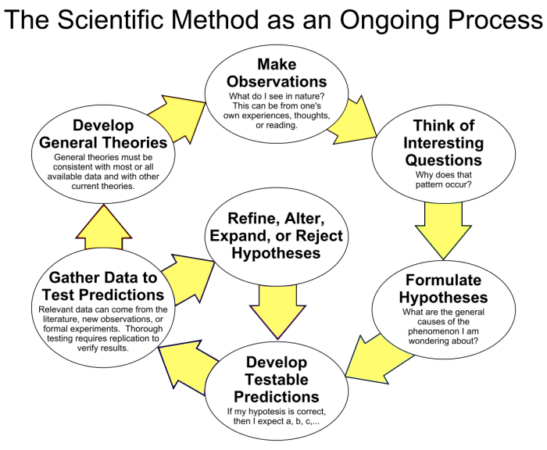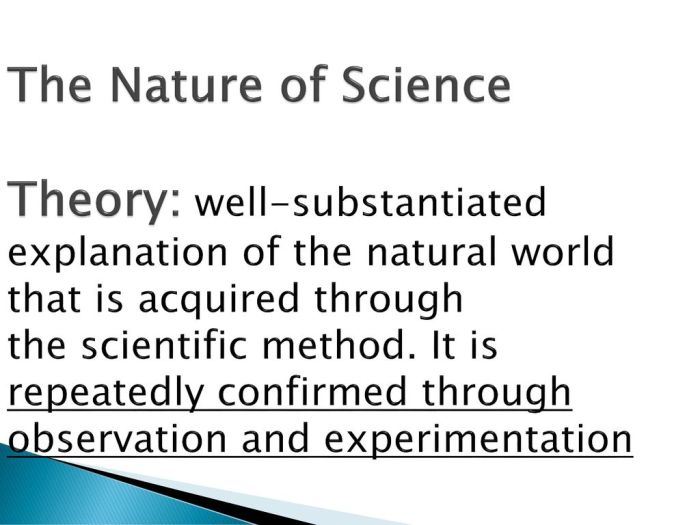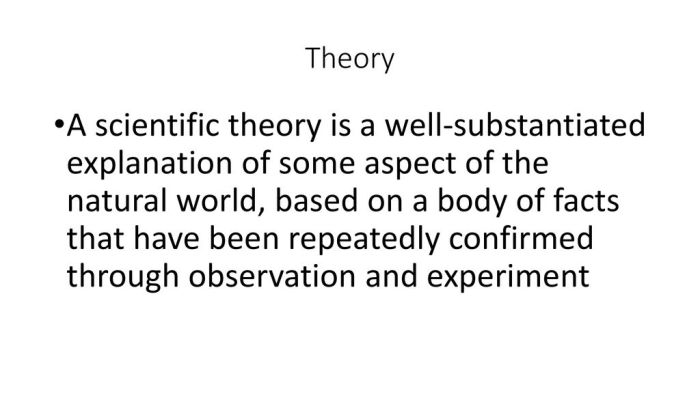
- The Nature of Law in Science: What Is Law In Science
- Laws in Different Scientific Disciplines
-
The Role of Laws in Scientific Progress
- The Contribution of Scientific Laws to Our Understanding of the Natural World
- The Limitations of Scientific Laws
- The Potential for Revision or Modification of Scientific Laws
- Designing an Experiment to Test the Validity of a Specific Scientific Law
- The Impact of Scientific Laws on Technological Advancements
- The Interplay of Law and Science
- Final Thoughts
- Key Questions Answered
What is law in science? This intriguing question delves into the very foundation of our understanding of the natural world. Scientific laws, unlike legal laws, are not decrees imposed by authority figures. Instead, they represent fundamental principles that govern the behavior of the universe, derived through rigorous observation, experimentation, and analysis.
These laws are not merely descriptions of how things happen but rather powerful predictions about how they will always happen under specific conditions. From the laws of motion that govern the movement of planets to the laws of chemistry that explain chemical reactions, scientific laws provide a framework for understanding the intricate workings of nature.
The Nature of Law in Science: What Is Law In Science

Scientific laws are fundamental principles that govern the behavior of the natural world. They are based on empirical evidence and observations, and they are used to explain and predict phenomena.
Fundamental Principles of Scientific Inquiry
Scientific inquiry is a systematic and logical approach to understanding the natural world. It is based on a set of fundamental principles that guide the process of investigation and discovery. These principles include:
- Empiricism: Scientific knowledge is based on observations and experiments. Scientists rely on evidence from the real world to support their claims.
- Objectivity: Scientific investigations should be conducted in an unbiased manner. Scientists strive to avoid personal biases and prejudices that could influence their results.
- Testability: Scientific hypotheses and theories must be testable. This means that they must be capable of being verified or falsified through experimentation.
- Parsimony: When multiple explanations for a phenomenon exist, the simplest explanation is usually the best. Scientists prefer theories that are concise and elegant.
- Reproducibility: Scientific findings should be reproducible by other scientists. This ensures that results are reliable and not due to chance or error.
Differences Between Scientific Laws and Legal Laws
Scientific laws and legal laws are distinct concepts with different purposes and applications. Scientific laws describe the natural world, while legal laws govern human behavior.
- Scope: Scientific laws apply to the entire universe, while legal laws are specific to a particular jurisdiction.
- Enforcement: Scientific laws are not enforced by any authority. They are simply descriptions of how the natural world works. Legal laws, on the other hand, are enforced by governments and courts.
- Changeability: Scientific laws can be revised or overturned as new evidence emerges. Legal laws can also be changed, but they are typically more stable than scientific laws.
Scientific Laws and Theories
Scientific laws and theories are both important components of scientific knowledge, but they have different roles.
- Scientific Laws: Describe a fundamental relationship between two or more variables. They are often expressed as mathematical equations.
- Scientific Theories: Provide a comprehensive explanation for a phenomenon. They are supported by a large body of evidence and are widely accepted by the scientific community.
Scientific laws are typically more specific than theories. They describe a particular relationship, while theories provide a broader framework for understanding a phenomenon. For example, Newton’s Law of Universal Gravitation describes the force of attraction between any two objects with mass. The theory of gravity, on the other hand, provides a broader explanation for how gravity works and its role in the universe.
The Role of Evidence and Experimentation
Evidence and experimentation are essential for establishing scientific laws. Scientists conduct experiments to test their hypotheses and gather data to support their claims. The results of experiments must be reproducible by other scientists to ensure that they are reliable.
- Experimental Design: Scientists carefully design experiments to control variables and minimize bias.
- Data Analysis: Scientists use statistical methods to analyze data and draw conclusions.
- Peer Review: Scientific papers are reviewed by other experts in the field before they are published. This helps to ensure that the research is of high quality and that the conclusions are justified.
The process of evidence gathering and experimentation is iterative. Scientists may revise their hypotheses or theories based on new evidence. This process of refinement helps to ensure that scientific knowledge is accurate and reliable.
Laws in Different Scientific Disciplines

Scientific laws are fundamental principles that describe and predict the behavior of natural phenomena. These laws are derived from meticulous observation, experimentation, and analysis, and they serve as cornerstones in various scientific disciplines. Exploring the nature of laws in different fields reveals the interconnectedness and universality of scientific principles.
Laws in Physics
Physics, the study of matter and energy, is characterized by numerous fundamental laws that govern the universe. These laws encompass diverse aspects of physical phenomena, from the motion of objects to the behavior of light and gravity.
- Newton’s Laws of Motion: These three laws, formulated by Isaac Newton in the 17th century, form the foundation of classical mechanics. They describe the relationship between force, mass, and acceleration. The first law states that an object at rest will remain at rest, and an object in motion will remain in motion at a constant velocity unless acted upon by an external force. The second law states that the acceleration of an object is directly proportional to the net force acting on it and inversely proportional to its mass. The third law states that for every action, there is an equal and opposite reaction. These laws are essential for understanding the motion of objects in everyday life, from falling apples to the orbits of planets.
- Law of Universal Gravitation: This law, also formulated by Newton, describes the attractive force between any two objects with mass. It states that the force of gravity is directly proportional to the product of the masses of the two objects and inversely proportional to the square of the distance between their centers. This law explains why objects fall to the ground, why planets orbit the sun, and why galaxies are held together.
- Laws of Thermodynamics: These laws describe the relationship between heat, work, and energy. The first law states that energy cannot be created or destroyed, only transferred or transformed. The second law states that the entropy of a closed system always increases over time. The third law states that the entropy of a system approaches a constant value as the temperature approaches absolute zero. These laws are essential for understanding energy transfer and transformation in various systems, from engines to living organisms.
Laws in Chemistry
Chemistry, the study of matter and its properties, relies on a set of fundamental laws that govern chemical reactions and the behavior of molecules. These laws provide a framework for understanding the composition, structure, and transformations of matter.
- Law of Conservation of Mass: This law states that in a closed system, the total mass of the reactants before a chemical reaction must equal the total mass of the products after the reaction. This law, formulated by Antoine Lavoisier in the late 18th century, highlights the fundamental principle that matter cannot be created or destroyed in ordinary chemical reactions.
- Law of Definite Proportions: This law states that a chemical compound always contains the same elements in the same proportions by mass, regardless of the source of the compound. This law, proposed by Joseph Proust in the late 18th century, emphasizes the consistency of chemical composition and the existence of fixed ratios in chemical compounds.
- Law of Multiple Proportions: This law states that when two elements combine to form more than one compound, the masses of one element that combine with a fixed mass of the other element are in ratios of small whole numbers. This law, proposed by John Dalton in the early 19th century, further reinforces the concept of fixed ratios in chemical compounds and provides insights into the formation of multiple compounds from the same elements.
Laws in Biology
Biology, the study of life, encompasses a wide range of phenomena, from the structure and function of cells to the interactions of organisms within ecosystems. While biological systems exhibit complexity and variability, certain fundamental laws and principles govern their behavior.
- Cell Theory: This theory, formulated in the mid-19th century by Schleiden and Schwann, states that all living organisms are composed of cells and that all cells arise from pre-existing cells. This theory revolutionized our understanding of life, emphasizing the fundamental unit of life and the continuity of life through cell division.
- Law of Segregation: This law, proposed by Gregor Mendel in the mid-19th century, states that during gamete formation, the two alleles for each trait separate from each other, so that each gamete receives only one allele. This law explains the inheritance patterns of traits and the diversity of offspring within a population.
- Law of Independent Assortment: This law, also proposed by Mendel, states that the alleles for different traits separate independently of each other during gamete formation. This law explains the combination of different traits in offspring and the variety of genetic combinations possible.
Laws in Astronomy
Astronomy, the study of celestial objects and phenomena, has uncovered fundamental laws that govern the universe on a grand scale. These laws describe the motion of stars, planets, and galaxies, and they provide insights into the origin and evolution of the cosmos.
- Kepler’s Laws of Planetary Motion: These three laws, formulated by Johannes Kepler in the early 17th century, describe the motion of planets around the sun. The first law states that the orbit of a planet is an ellipse with the sun at one focus. The second law states that a line joining a planet and the sun sweeps out equal areas in equal times. The third law states that the square of the orbital period of a planet is proportional to the cube of the semi-major axis of its orbit. These laws revolutionized our understanding of planetary motion and provided the foundation for Newton’s law of universal gravitation.
- Hubble’s Law: This law, formulated by Edwin Hubble in the 1920s, states that galaxies are moving away from each other at a speed proportional to their distance. This law, based on the observation of redshift in the light from distant galaxies, provided evidence for the expansion of the universe and the Big Bang theory.
Comparison of Laws of Motion in Classical Physics and Quantum Mechanics
Classical physics, based on Newtonian mechanics, describes the motion of objects at macroscopic scales. Quantum mechanics, developed in the early 20th century, describes the motion of particles at microscopic scales. While both theories provide frameworks for understanding motion, they differ in their fundamental assumptions and predictions.
| Classical Physics | Quantum Mechanics |
|---|---|
| Objects have definite positions and momenta at all times. | Particles have wave-like properties and their positions and momenta are uncertain. |
| Motion is continuous and deterministic. | Motion is quantized and probabilistic. |
| Objects obey Newton’s laws of motion. | Particles obey the principles of quantum mechanics, such as the Heisenberg uncertainty principle and the Schrödinger equation. |
The Role of Laws in Scientific Progress
Scientific laws play a pivotal role in advancing our understanding of the natural world. They serve as fundamental principles that govern the behavior of physical systems, providing a framework for interpreting observations and predicting future events.
The Contribution of Scientific Laws to Our Understanding of the Natural World
Scientific laws provide a concise and powerful way to summarize vast amounts of experimental data. By identifying consistent patterns and relationships in nature, laws allow us to make sense of the complex world around us. For instance, Newton’s Law of Universal Gravitation explains the force of attraction between any two objects with mass. This law has been instrumental in understanding the motion of planets, the formation of galaxies, and even the behavior of tides.
The Limitations of Scientific Laws
While scientific laws are powerful tools, it’s important to recognize their limitations. Laws are based on observations and experiments conducted under specific conditions. They may not hold true in all situations or at all scales. For example, Newton’s laws of motion, which are fundamental to classical mechanics, break down at very high speeds or in very strong gravitational fields, where the principles of relativity become more relevant.
The Potential for Revision or Modification of Scientific Laws
Scientific laws are not immutable truths. They are subject to revision or modification as new evidence emerges or as our understanding of the natural world evolves. For instance, the discovery of quantum mechanics in the early 20th century led to a significant revision of classical physics, particularly in the realm of atomic and subatomic phenomena.
Designing an Experiment to Test the Validity of a Specific Scientific Law
To test the validity of a scientific law, scientists design experiments that aim to either confirm or refute the law’s predictions. Consider the example of testing the Law of Conservation of Energy. This law states that energy cannot be created or destroyed, only transformed from one form to another. To test this law, we could design an experiment where we measure the total energy of a closed system before and after a specific process. If the total energy remains constant, it would support the validity of the Law of Conservation of Energy.
The Impact of Scientific Laws on Technological Advancements
Scientific laws have had a profound impact on technological advancements. Our understanding of fundamental principles has led to the development of numerous technologies that have transformed our lives. For example, the laws of electromagnetism, discovered by Faraday and Maxwell, laid the foundation for the development of electric motors, generators, and countless other electrical devices.
The Interplay of Law and Science
Science and law, though seemingly distinct disciplines, are intricately intertwined, shaping and influencing each other in profound ways. Scientific discoveries and advancements often serve as the foundation for legal frameworks, while legal regulations can, in turn, guide and constrain scientific research and development. This dynamic interplay is particularly evident in areas like environmental regulations and medical ethics, where scientific knowledge and legal principles converge to address complex societal challenges.
The Influence of Scientific Laws on Legal Frameworks
Scientific laws provide a fundamental understanding of the natural world, offering insights into how systems function and interact. This knowledge is crucial for developing effective legal frameworks that aim to protect the environment, safeguard public health, and ensure ethical scientific practices. For instance, the laws of thermodynamics, which govern energy transfer and transformation, have influenced the development of environmental regulations aimed at reducing pollution and promoting energy efficiency. Similarly, the principles of genetics and evolution have shaped legal frameworks related to genetic engineering and biodiversity conservation.
Ethical Implications of Scientific Discoveries
Scientific advancements often raise profound ethical questions that necessitate legal intervention. The discovery of new technologies, such as genetic engineering and artificial intelligence, presents both opportunities and challenges that require careful consideration and ethical guidelines. Legal frameworks play a vital role in establishing ethical boundaries for scientific research and ensuring that its applications are aligned with societal values. For example, the development of stem cell research and gene editing technologies has sparked intense ethical debates, leading to the establishment of legal regulations to govern their use.
Examples of Scientific Laws Influencing Legal Decisions, What is law in science
Throughout history, scientific laws have played a significant role in shaping legal decisions and policies. Here are a few notable examples:
- The Laws of Motion and Traffic Safety: Isaac Newton’s laws of motion, which describe the relationship between force, mass, and acceleration, have been instrumental in designing safer vehicles and developing traffic regulations. These laws have contributed to the development of safety features like seatbelts, airbags, and anti-lock braking systems, which have significantly reduced the severity of traffic accidents.
- The Laws of Thermodynamics and Climate Change: The laws of thermodynamics, particularly the second law, which states that entropy always increases in an isolated system, have been used to understand the phenomenon of climate change. The scientific consensus on climate change, based on these laws and observational data, has led to the development of international agreements and national policies aimed at mitigating greenhouse gas emissions.
- The Laws of Genetics and Forensic Science: The laws of genetics, particularly the principles of DNA inheritance, have revolutionized forensic science. DNA profiling techniques, based on these laws, have become a powerful tool for identifying individuals, solving crimes, and exonerating wrongly convicted individuals.
A Timeline of the Interplay Between Science and Law
The interplay between science and law has evolved over centuries, with each discipline influencing and shaping the other. Here is a brief timeline highlighting some key moments in this dynamic relationship:
- Ancient Greece (c. 6th century BC): Early Greek philosophers, like Hippocrates and Aristotle, laid the foundation for scientific inquiry and medical ethics. Their ideas influenced the development of legal systems and medical practices in ancient societies.
- The Scientific Revolution (16th-18th centuries): The Scientific Revolution, marked by the work of scientists like Copernicus, Galileo, and Newton, led to a shift in understanding the natural world. This scientific revolution contributed to the development of modern legal frameworks based on reason and evidence.
- The Industrial Revolution (18th-19th centuries): The Industrial Revolution brought about rapid technological advancements and societal changes, raising new ethical and legal challenges. The development of factory systems, pollution, and worker safety issues led to the emergence of labor laws and environmental regulations.
- The 20th Century and Beyond: The 20th century witnessed significant scientific breakthroughs in fields like medicine, physics, and genetics. These discoveries raised complex ethical and legal questions, leading to the development of international agreements, national regulations, and bioethics committees to address these challenges.
Final Thoughts

The concept of “law” in science is a testament to the remarkable power of human inquiry. Through careful observation, experimentation, and rigorous analysis, we have uncovered fundamental principles that govern the universe. These laws not only deepen our understanding of the natural world but also provide a foundation for technological advancements that continue to shape our lives. As we continue to explore the universe and its mysteries, the pursuit of scientific laws will undoubtedly remain a cornerstone of human knowledge.
Key Questions Answered
What is the difference between a scientific law and a scientific theory?
A scientific law describes a fundamental principle that governs the behavior of the natural world, while a scientific theory explains a broader phenomenon and is supported by a vast body of evidence. Laws are generally considered to be more established and universally accepted than theories, but both are essential components of scientific knowledge.
Can scientific laws be broken?
Scientific laws are not “broken” in the sense of being violated. They are fundamental principles that hold true under specific conditions. However, they can be refined or modified as new evidence emerges and our understanding of the universe evolves.
How are scientific laws used in everyday life?
Scientific laws are the foundation of countless technologies that we rely on every day. From the design of airplanes and bridges to the development of medicines and communication systems, scientific laws play a crucial role in shaping our world.





